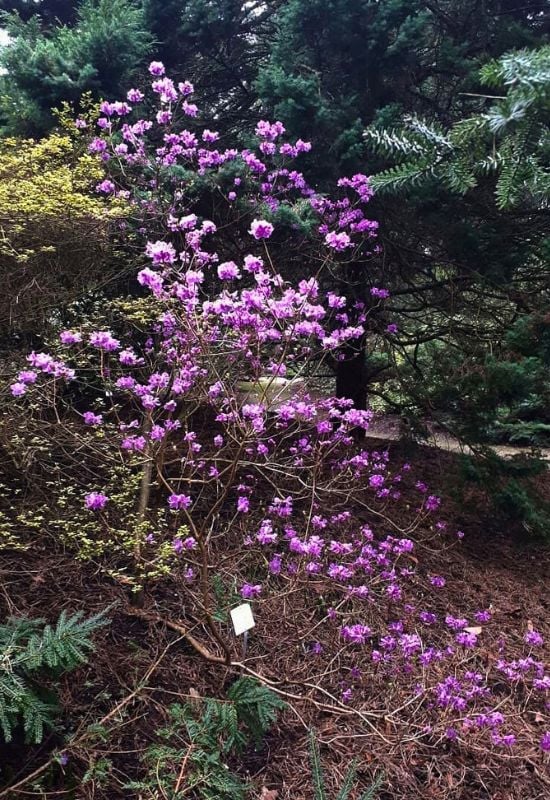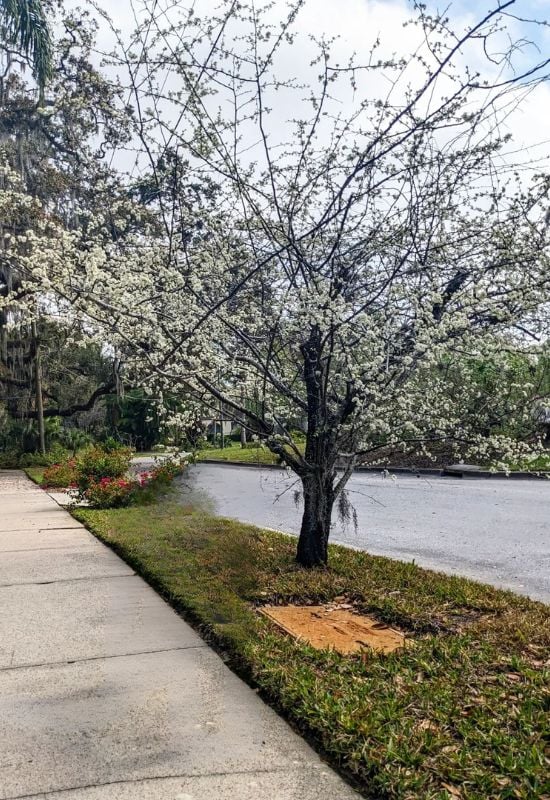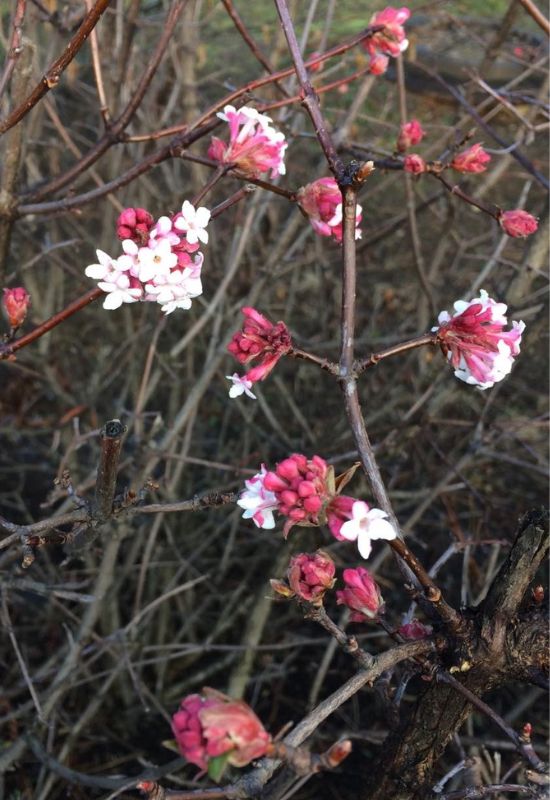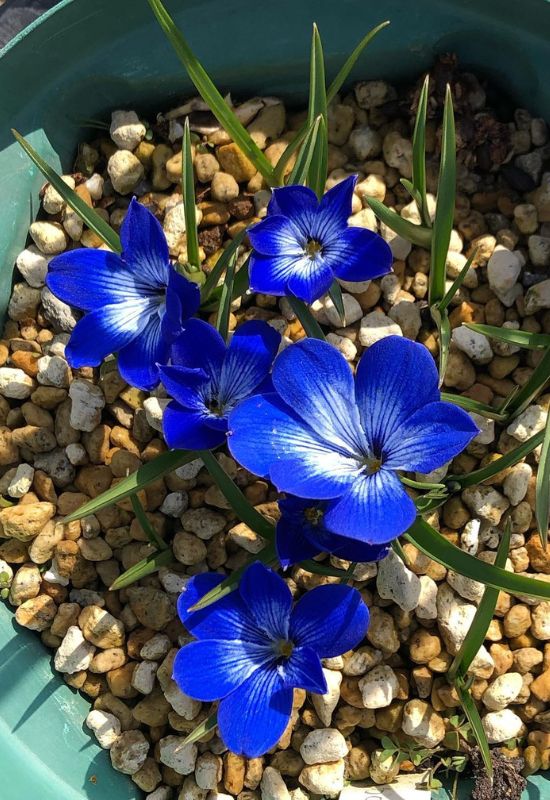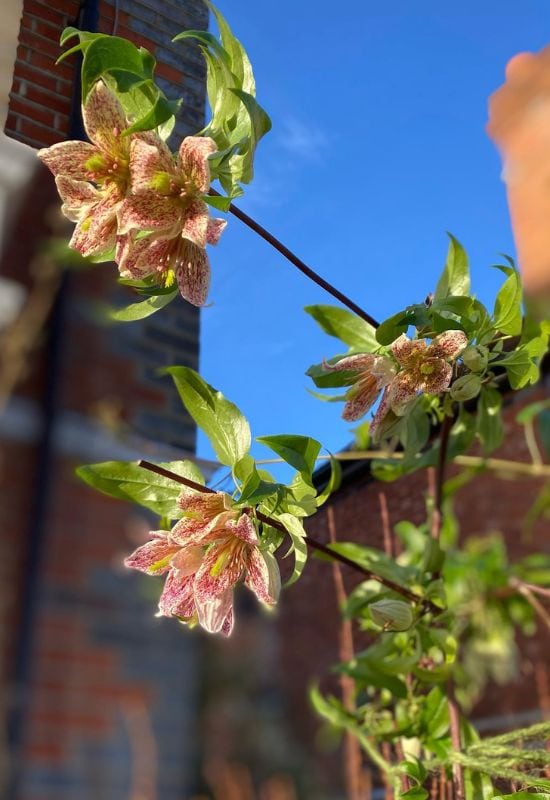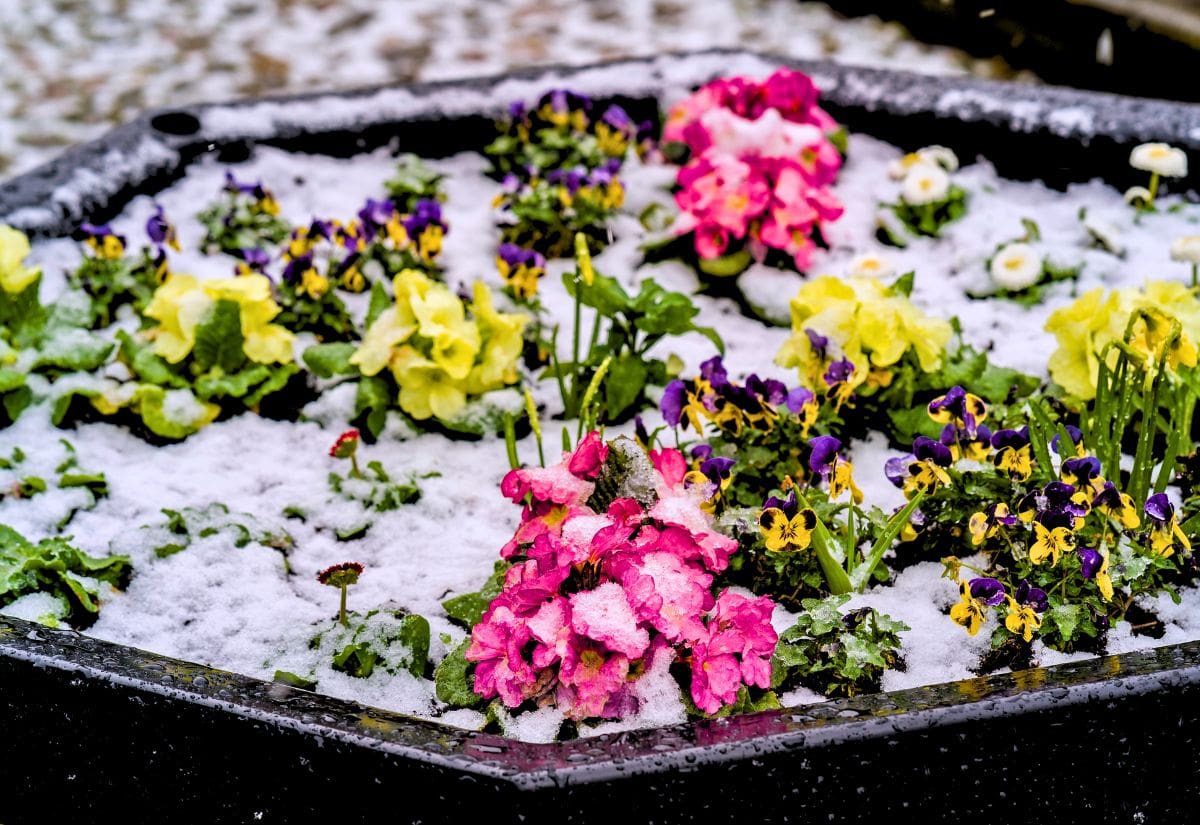
Winter is a season of cold, snow, short days and flowers! Yes, because there are plant varieties that blossom when very few others do, and some even in very low temperatures!
Just think about the value that these perennials and shrubs can bring to your garden: just when you need it most, they will fill your green haven with colorful blooms!
Of course, tropical and exotic gardens are easy to fill with blossoms at this time, but how about if you live in a continental, temperate or even colder region?
Don’t worry, there are flowering plants that will open their buds even in these harsh conditions!
Absolutely, winter-blooming plants are a rare delight. If you’re eager to keep your garden or terrace vibrant and stunning with unique, off-season flowers, stay tuned!
I’m excited to share with you 18 incredible plants that blossom in the snow, bravely standing up to the winter chill!
The 18 Flowering Plants That Will Keep Your Garden in Bloom in Winter, and in Cold Regions As Well!
Some of these flowering plants will bloom even when snow is falling on your garden, and I have some surprises for you in the varieties I have found to fill your winter garden with flowers… Yes, even exotic ones! So here they are…
To help you along with your choice, I will start with the most cold hardy varieties, and then moved up the USDA hardiness zone to continental climates. And the very first is a real must in any winter garden!
1. Hellebore (Helleborus spp.)
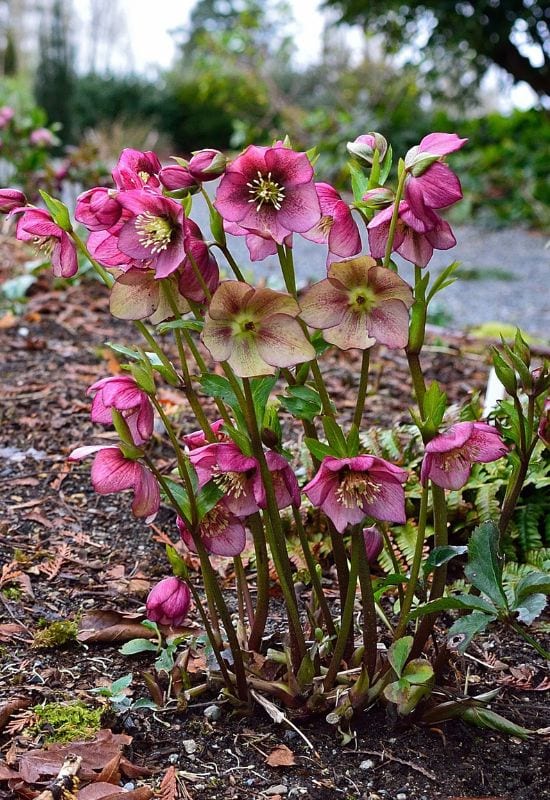
Also called “lenten roses” hellebores are the unmatched protagonists of winter gardens. While some varieties will bloom at other times, most will keep your garden lush and colorful with their large and round flowers, reaching up to 3.2 inches across (8.0 cm).
And there is another thing you must appreciate about the Helleborus genus – it has an incredible palette to paint your cold days, with black (deep purple) and whit, but also a range of very delicate tonalities in between.
So, you can grow ‘New York Nights’ or ‘Dark Handsome’, some of the darkest varieties, or the double snow colored ‘Wedding Bells’, but also the apricot ‘Sandy Shores’, or the green Helleborus viridis.
But there is more that this perennial can offer you; its lovely set of broad palmate or pedate leaves, usually evergreen, and clumped beautifully to cover the ground.
Quite easy to grow and self-propagating, hellebores will also suit shady spots in your winter garden, and they are quite cold hardy indeed, so they will be in bloom even when your land is covered in a white coat of snow!
2. Crocus (Crocus spp.)
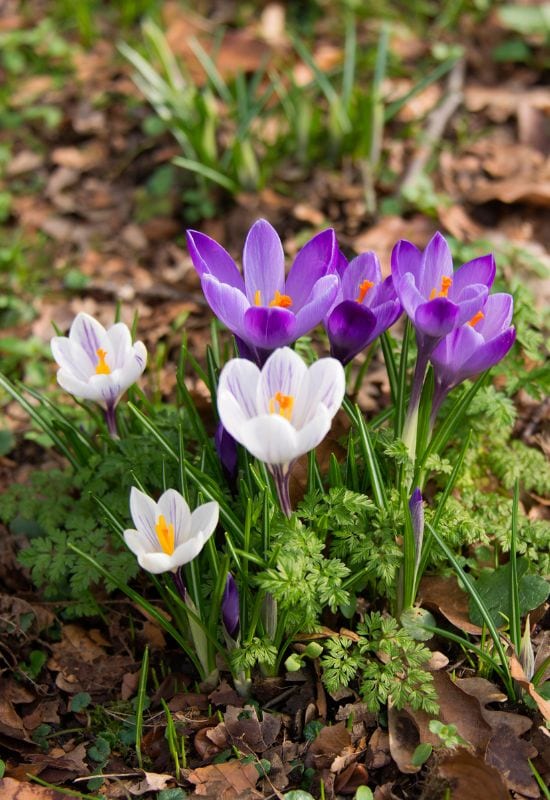
Crocus is yet another classic of the late winter and early spring garden. This sweet looking bulbous (cormous, to be precise) perennial is easy to grow and cheap to buy, and it naturalizes so easily that you can fill whole fields with them.
Cup shaped and looking up to the sky, its flowers are small but very colorful, keeping close to the ground and looking like they stand on their own from a distance, because the tiny needle like leaves are almost invisible next to their blossoms.
With more than 100 species and many more cultivars, you have a wide range of colors to choose from. But they mainly give you white, mauve, lavender, purple, yellow and orange. There are also bicolor varieties and “giant” ones, if you are after a more showy effect!
Whether you want to grow crocuses in early blooming flower beds, containers or even in rock gardens, or you want them to naturalize and spread under shrubs and trees, or in a lawn to give you winter and spring blossoms, you have a wide choice and really little work to do. And they are very cold hardy as well!
3. Snowdrop (Galanthus spp.)
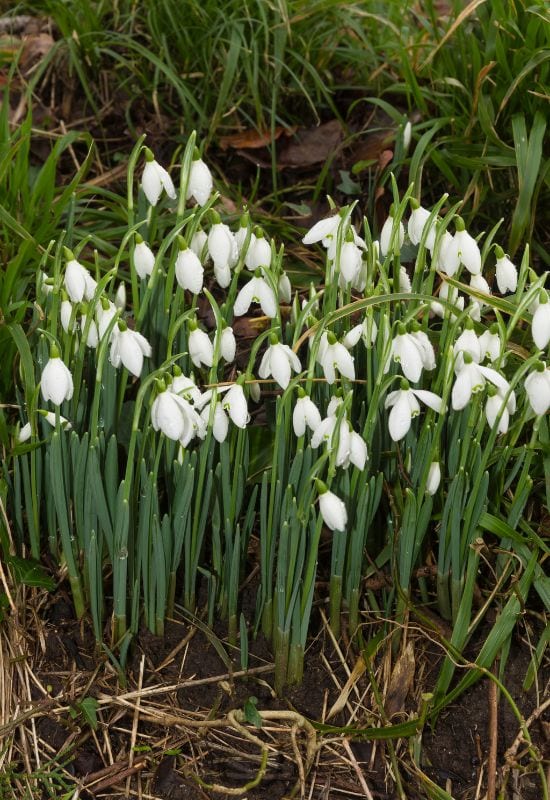
Of course, the winter theme in the common name of Galanthus extends to its blooming season, from February to March, and it is not uncommon to see snowdrops actually in flower the the snow is still covering the land…
And again, the color of this cold hardy bulbous perennial too is in keeping with their bright and pure white, but with a dot, or drop of green crown (“called inner perianth segments” by scientists) that nods elegantly under the oval and bigger tepals that shelter it (“outer perianth segments”).
But few people know that it also has a spathe that arches on top of the hooked flowering stem, while we all know that it has lovely, green leaves and elongated leaves…
There are single and double varieties, and even “giant” cultivars, but I prefer the classical look of single ones…
Very easy to grow and naturalize, snowdrop varieties have won an impressive 27 Awards of Garden Merit by the Royal Horticultural Society! What a big harvest of medals for a small bulbous perennial for your winter garden, in rockeries, containers, flower beds or also under shrubs and trees!
4. Sweet Violet (Viola odorata)
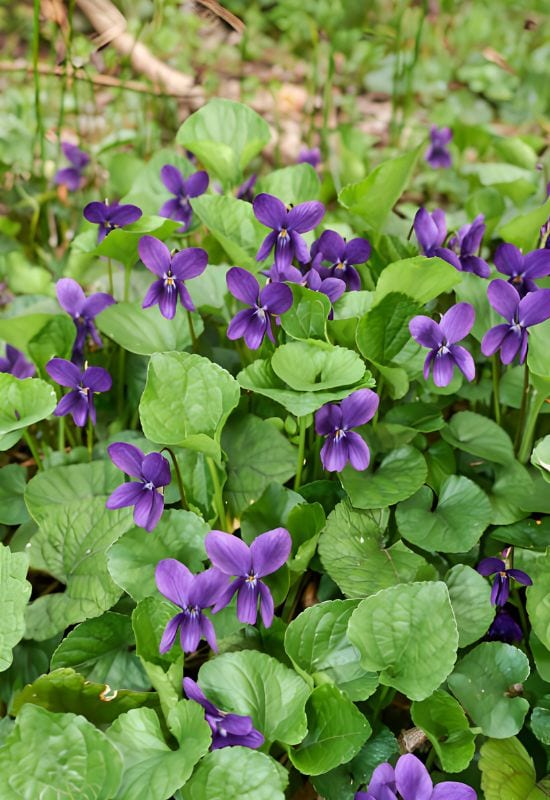
…And the classic sweet violet is yet another perennial that will blossom in your garden in late winter and early spring! This small Viola variety from Europe and Asia may have smaller flowers than bigger pansies, less than 1 inch across (2.5 cm), but they beat her more showy sisters in time!
And in scent, because this is the actual species that gives us the standard “violet fragrance”!
Coming on hooked stems quite generously, its blossoms have the iconic 5 petals of this genus, and you can guess the color, because it actually takes its name from this little but cold hardy plant!
But look in the center, and you will see delicate veins (or whiskers) leading pollinators to a yellow dot, where they can find nutritious nectar when they need it most! But wait, you too can eat the flowers, which are also made into sweets in its native region.
And then, you get those lovely clumps of bright emerald green, hear shaped leaves to cap it all!
Strong and vigorous, sweet violet is a winter blooming perennial that you can naturalize under shrubs or trees, or keep it in your flower beds, for edging, or in containers and rock gardens!
5. Winter Aconite (Eranthis hyemalis)
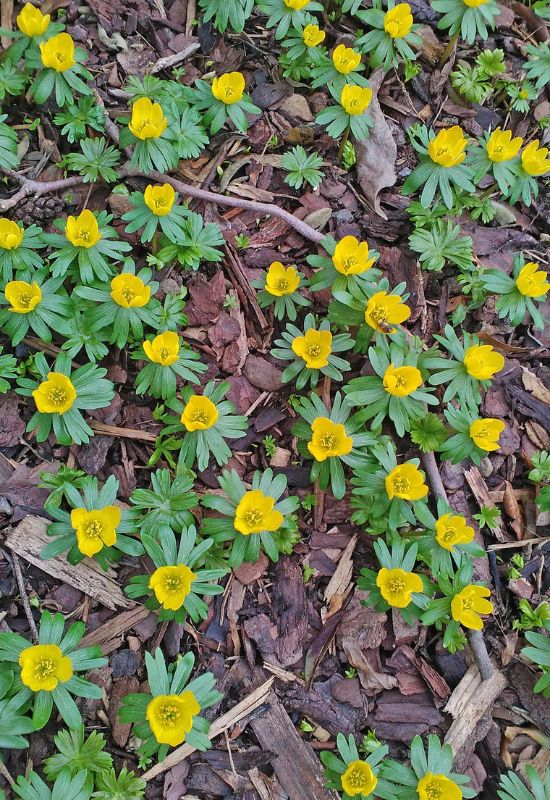
Another winner of the prestigious Award of Garden Merit by the Royal Horticultural Society and another tiny cormous perennial, also winter aconite has our season in its name – both of them! And in fact, it will spark up your garden in February and March with its cup shaped and round flowers in the brightest golden yellow shade ever!
They will look up to you from low down, near the soil (maybe still snow covered), and their lustrous, silky and almost waxy texture of its blossoms adds extra luminosity to this display. But the 6 long and oval petals are also framed by a a ring of lovely leaf like bracts, which are deep green, like a saucer under a bowl! And its leaves too add a fine structure to the early days of your garden, with their rich color and fingered shaped clumps.
Winter aconite is yet another winter flowering perennial you can naturalize on your land, also under trees and shrubs, but it will look great in flower beds, containers or also next to paths, and – why not? – in a rockery as well!
6. Winter Honeysuckle (Lonicera fragrantissima)
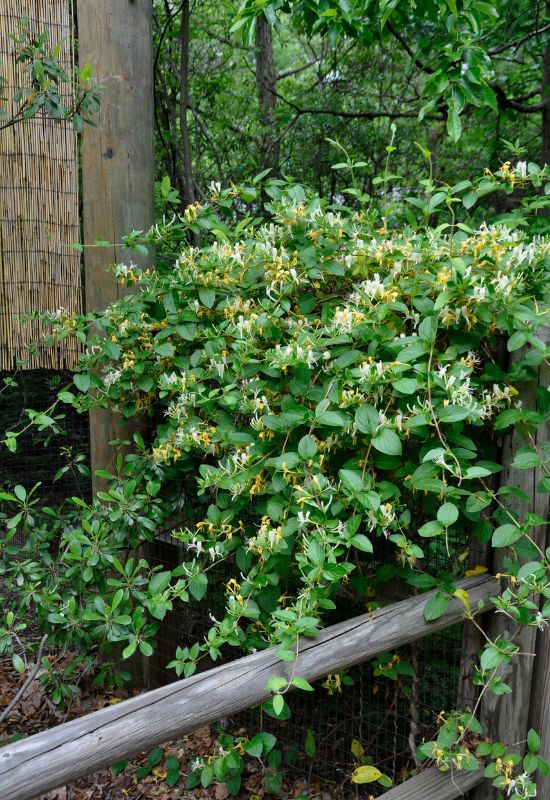
As you may have guessed, Lonicera fragrantissima is an unusual species of honeysuckle, because it blossoms from mid winter to early spring! But its scientific name will give you another clue about this deciduous shrub: that its flowers are extremely fragrant and sweetly scented too!
The flowers will come when the foliage is yet to grow or just about unfurling, in terminal clusters with the typical arching and trumpet shape of this genus, opening to round lips and with protruding stamens ending in pale yellow anthers. But this floral display also adds another note in theme with our season; the snow white color that, at peak times, covers the whole shrub!
When the ovate leaves emerge, you will also enjoy its lush semi glossy sheen and the change from bright to mid and even dark green till it blushes in yellow and orange, then drops to the ground by late fall.
A medium to large flowering shrub, winter honeysuckle is a favorite with hummingbirds, adding an extra colorful note to your garden, and you can grow it as a specimen, or in a hedge or even tall border, maybe at the back. Or keep it close to your house, growing it for foundation planting!
7. Japanese Andromeda (Pieris japonica)
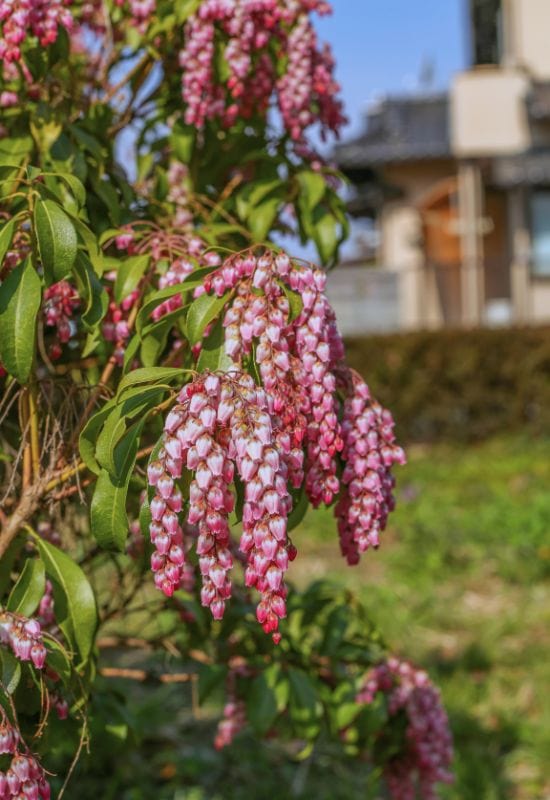
You will get evergreen and lush foliage all year round with Japanese Andromeda, but its best display comes in late spring and early summer, when it is in full bloom! In fact, when all is quiet and snow covers your land, thus shrub produces masses of cream white flowers with a pink blush in large clusters of nodding, urn shaped blossoms, and they are very fragrant as well! But this amazing out of season spectacle is accompanied by another one as well…
The new leaves that emerge more abundantly just after this elegant floral display, in spring, and they are reddish in color, especially in the cultivar ‘Red Head’, with shades of cerise and even pinkish… Lance shaped and very dense indeed, they will later turn deep green, but keeping a glossy sheen that heightens their leafy beauty!
Low maintenance and easy to grow, Japanese Andromeda can grace your winter (and all year round) garden as a specimen shrub, but also in borders or for foundation planting. Suitable to natural looking and informal gardens, you can easily grow it in an oriental landscape as well, being native to China, Japan and Taiwan.
8. Persian Violet (Cyclamen coum)
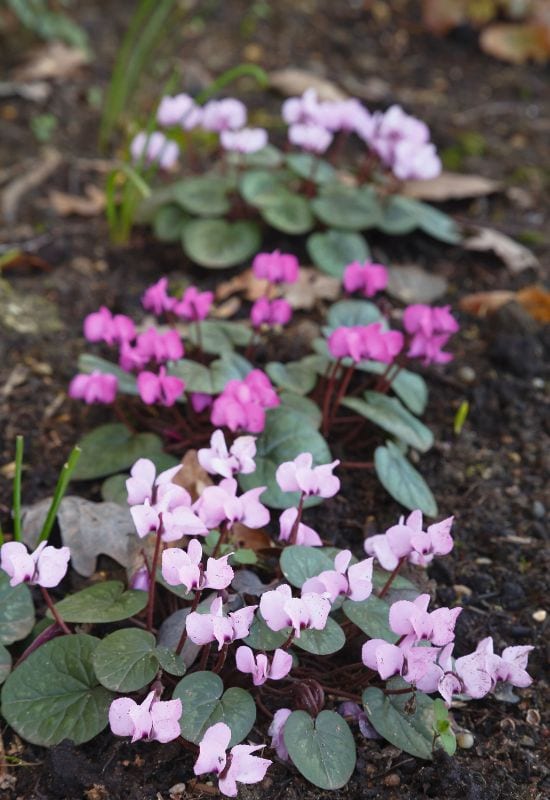
Persian violet is a cold hardy variety of cyclamen (C. coum), which blossoms in late winter and early spring! Native to the Mediterranean Basin, this tuberous perennial has the most classic look of its genus as well! Its flowers are typically reflexed, and nodding on hooked stems that come straight from the soil (scapes), and they can be white to purplish in color, with pinkish and lavender or mauve tonalities.
It has also has won two Awards of Garden Merit by the Royal Horticultural Society, with the mother species, and its bright lilac pink blooms, heart shaped leaves in deep green, with silver dots on them, for example. But it also got the prize with ‘Maurice Dryden’ (Cyclamen coum subsp. coum f.coum Pewter Group), with white flowers and broad petals, flushed with rose at the base and amazing large, glossy and dark green foliage, with a veneer of silver in the middle. Or, for warmer climates (USDA zone 9 to 11), you can get an even longer display with Persian cyclamen (Cyclamen persicum) lasting all the way from fall to late spring!
Shade loving and cold hardy, Persian violet can naturalize very easily under trees and shrubs, including conifers (!!!) and in woodland areas, but it will equally warm up you winter garden in flower beds, rockeries and containers!
9. Heather (Erica spp.)
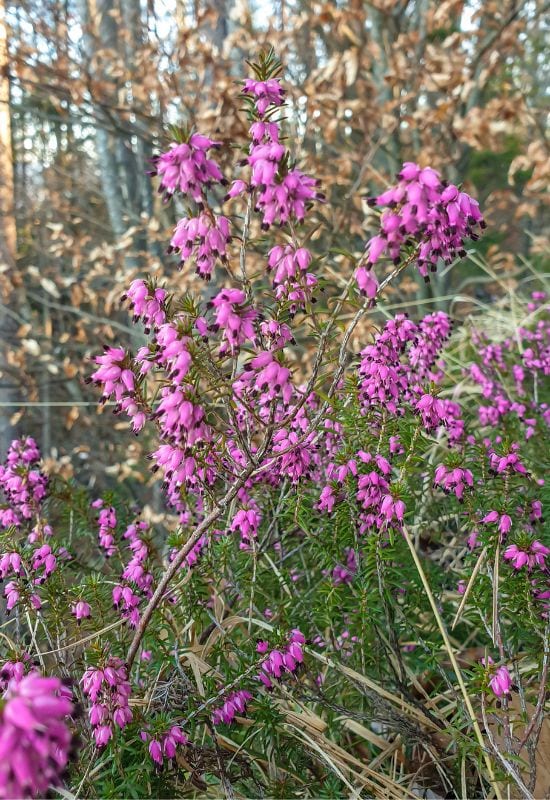
Also called winter heath, heather creates massive floral spectacles in our season, and the species Erica carnea, which grows spontaneous on the mountains of central and southern Europe, is one of the most cold hardy! Blossoming for months on end, from mid winter to late spring, it literally covers with its nodding and urn shaped florets, so that whole valleys change color… And you can choose between white, pinks and purple shades, forming carpets in your garden!
Loved by little pollinators, this small dwarf shrub has also won a whopping 11 Awards of Garden Merit by the Royal Horticultural Society with its many varieties, making it a real champion and marathon bloomer! The little branchlet will look alive all year round, thanks to the many, evergreen, needle like and dark green little leaves that cover them.
Heather is a great winter flowering little plant to grow as ground cover, but also for edging, in rock gardens, containers and coastal areas, and outstanding on banks and slopes. In the end, it holds up whole hills in the wild! But it does like acidic soil…
10. Witch Hazel (Hamamelis x intermedia)
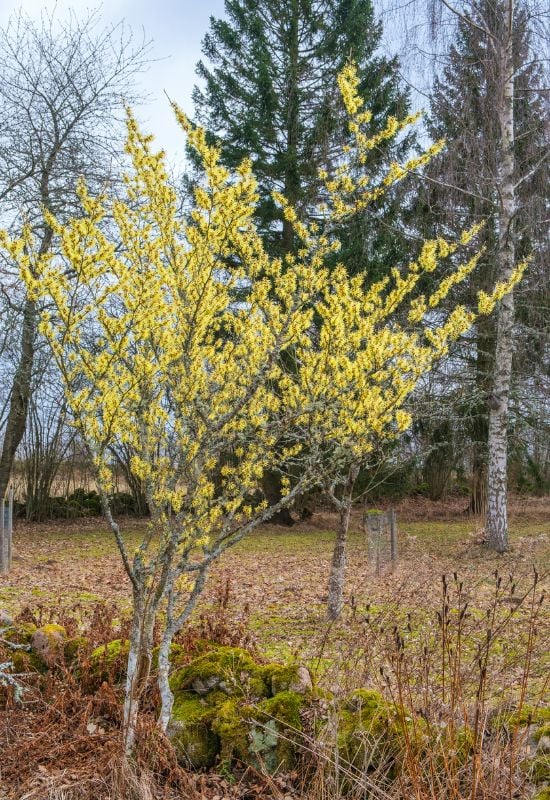
Witch hazel is a deciduous shrub, but, if in winter it has no foliage, its naked branches will fill with lots of flowers! They are actually quite weird in appearance, as each blossom has four, long, ribbon like and crinkled petals, and they look a bit like spiders. These grow from a purple calyx, and they can be bright yellow in the cultivars ‘Sunburst’ and ‘Starlight’ or pinkish cerise in ‘Feuerzauber’ or pale tangerine in ‘Orange Peel’.
This hybrid also has 4 winners of the Award of Garden Merit by the Royal Horticultural Society, the carrot blooming ‘Gingerbrard’, the deep saffron to sulfur ‘Barmstedt’, the ruby red ‘Rubin’ and ‘Vesna’, which has a yellowish pink shade. All, however, are sweetly fragrant, and all are very generous indeed. It is a cold hardy plant, but it protects its floral display buy curling up the flowers on freezing days, and opening them on milder ones… Come spring, it will grow its broad, wrinkled leaves too, which stay fresh through the season deepening in tonality, till they blush to orange and yellow in fall.
Strong and fast growing, witch hazel in all its varieties is an excellent shrub to grow in wind screens, hedges or also woodland areas, but its floral display makes it a worthy specimen plant as well, as long as you keep it in an informal setting or garden.
11. ‘Mid Winter’ Rhododendron (Rhododendron duaricum ‘Mid Winter’)
Surprise, surprise, you can even grow a rhododendron that to have flowers in our cold and snowy season, ‘Mid Winter’! Of course, its name is a giveaway, but partly misleading, because it will blossom in February and March, and it has been bred especially to give us its impressive floral display at this time. But this has been a very successful experiment, because it is also a very floriferous variety!
A sea of saucer shaped, bright rose to magenta bloom will fill the branches of this shrub, lighting up your garden with vibrant and uplifting energy! Each head is about 1.5 inches across (4.0 cm), and you may enjoy this spectacle on naked branches (in colder regions) or with foliage on (in warmer countries). In fact, it is a semi evergreen cultivar, and its glossy, small ovate leaves will add texture to your paradise with their deep green color. All these qualities have gained it the Award of Garden Merit by the Royal Horticultural Society.
A great choice to have flowers in winter, you will literally amaze your visitors if you grow ‘Mid Winter’ rhododendron in your garden. You can have it in hedges, shrub borders or even on banks and slopes, and it is ideal for all informal designs, including, of course, oriental!
12. Chickasaw Plum (Prunus angustifolia)
Chickasaw plum was originally cultivated by Native Americans before Europeans arrives, and in fact, it also goes by the name of Cherokee or Florida plum… And it will blossom from late winter to mid spring! This is quite a long season for a Prunus variety… The whole tree will literally fill with white five petaled flowers, which look very delicate and dainty, and the long stamens add a touch of sophistication with their golden and round anthers…
Great to provide food early in in the season to pollinators and keep your garden healthy, these blooms will open on the still naked purplish branches, and it is such a floriferous species that you may well think that a cloud has descended from the sky and fallen on your land! Then the long and ovate leaves emerge in a bright and luminous green shade, and they will keep deepening in color till they blush to yellows and oranges and reds in fall…
But wait! In the meantime, around June and July, you will also harvest the juicy fruits that dangle from under its now lush crown, and enjoy not just their flavor, but their colors, ripening to yellow, then ruby red, then, well, plum of course! P
Chickasaw plum will work well in any informal and traditional looking garden, always bringing you a country or cottage feel, whether you grow it as a decorative or harvest tree, or both! You can grow it as a specimen or in groups, and enjoy its winter blossoms for many years!
13. Winter Jasmine (Jasminum nudiflorum)
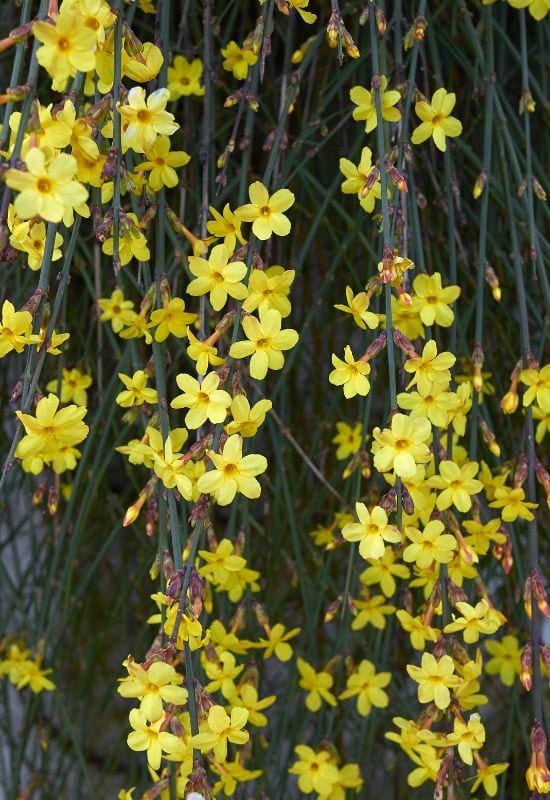
Of course, winter jasmine will blossom in the cold season, and exactly in February and then into March, and quite abundantly too! And it will do it when the branches are still naked, so you will ged cascades of gold in your garden, providing early food for pollinators, with the bright yellow of its flowers!
The many blooms are trumpet shaped, but they open to wide stars with 6 oval shaped petals, but while this will bring light, warmth and energy in the cold and short days of this rime of year, they will not bring you any scent. Yes, unfortunately it is a non fragrant variety. But still… Then, after this vibrant floral display is over, the many flexible arching branches will fill with shiny green trifoliate leaves, which will provide texture and a fresh presence to your corner of heaven till fall, almost touching the ground and they descend elegantly.
A very decorative winner of the Award of Garden Merit by the Royal Horticultural Society, winter jasmine is also easy to grow, as a specimen plant, near retaining walls or for foundation planting or to spark up hedges or the back of borders with waterfalls of bright yellow flowers.
14. Farrer Viburnum (Viburnum farreri)
With Farrer viburnum, you can literally keep your garden flowering all through the cold season, and beyond! In fact, this hardy shrub from northern China will start its amazing floral display in late fall and the main wave will continue into early winter, but expect even more flushes all the way till mid spring! And what will you get all this time? Round and dense clusters of enchanting pink and trumpet shaped flowers that open to stars!
Very floriferous, this deciduous shrub will follow its bloom with red berries, which ripen to black later on, attracting little birds to your land… With a round habit, it will also give you lush foliage, which starts off with green, ovate and serrated leaves, deepening in shade in summer, then they blush to red and purple to bid you farewell and leave the spotlight to its blossoms as days get cold.
A wonderful choice for hedges or at the back of tall borders, Farrer viburnum can also take center stage in your winter garden as a specimen shrub, as long as you keep your space informal and natural looking.
15. Camellia (Camellia japonica)
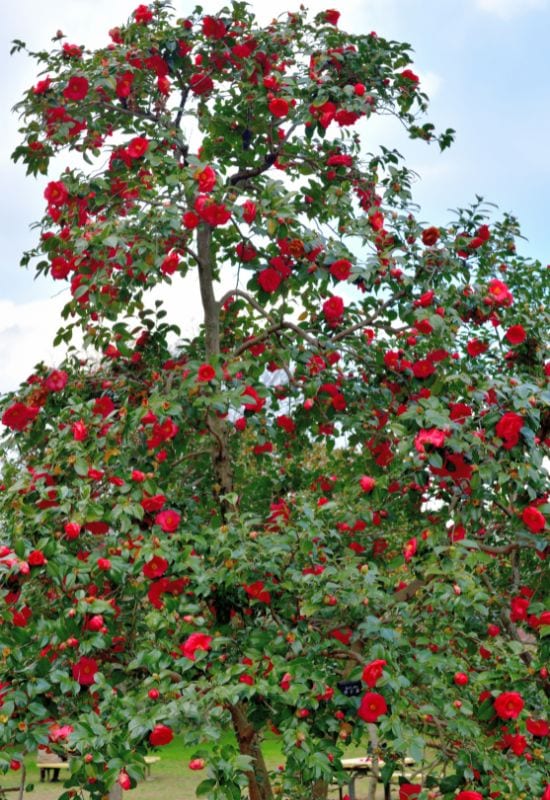
And we finally meet the queen of winter gardens: camellia! This evergreen shrub brings you rose like blooms of the most exquisite, elegant and iconic beauty, showy and yet traditional looking at the same time, but with an exotic touch. Make sure you grow a C. japonica though, because C. sasanqua will blossom in fall…
This species alone (and 4 hybrids) has received a mind blowing 61 (!!!) Awards of Garden Merit by the Royal Horticultural Society, but you could also grow Camellia hiemalis, which will flower from late fall to late spring, but it has “only” got two of the RHS prizes… And you can then pick the flower color, with white, pink or red, single or double heads, formal and informal, peony shaped flowers or fragrant ones… The lustrous, deep green, ovate evergreen foliage will give you a striking dark backdrop, and natural bouquets to warm up the cold days of this season.
Camellias need acidic soil to thrive, and if you don’t have it, maybe it is a good idea to grow them in containers, otherwise, as specimen shrubs or as part of a flowering hedges, they will always steak the show in winter! And yes, they are also suitable to Japanese and Oriental gardens!
16. Blue Chilean Crocus (Techophilaea cyanocrocus)
As you can see from its binomial name, Techophilaea cyanocrocus is not actually a real crocus variety, but a different exotic species from Chile. But it grows at very high altitudes on mountains, between 2,000 and 3,000 meters (6,600 to 9,800 feet!), which makes it more tolerant to colder climates (temperate to transition).
It does look a bit like the famous the famous bulbous perennial, though its flowers are actually trumpet shaped, opening more fully to little stars that look up to the sky, and they can be up to 1.6 inches across (4.0 cm). What is more, they bloom at the same time as actual crocuses, so they are ideal for a late spring and early winter garden. And of course, it offers you the strongest, most vibrant and almost electric cobalt blue shade! Its leaves are rich green, and grass blade like, rather than needles, and it is a protagonist of the Davies Alpine House and Rock Garden at Kew, London.
You understand that blue Chilean crocus is ideal for rock gardens, also thanks to its mountain origin, but it can grace your late winter and early spring days with its super blue blossoms also in flower beds or containers.
17. ‘Advent Bells’ Clematis (Clematis napaulensis x cirrhosa ‘Advent Bells’)
I am going to surprise you again… Yes, you can have really exotic blossoms in your winter garden, with a clematis (!!!) cultivar that was bred on purpose to be in full bloom during this cold and harsh season, ‘Advent Bells’. This climber will open its buds from late fall into mid winter with great vigor, and then it will give you more flushes up to May…
Its four petals are ivory white at the back, but this color is just the backdrop to a vibrant scattering of raspberry purple dots and dashes at the front, which lead your eye to the center of the blossom, where light lime, tubular pistil is crowned by pointed pastel and pale pinkish to cream pistils, ending in delicate ethereal violet anthers!
To be honest, the actual shades can light up in the right conditions, touching more intense notes towards the red range… After the floral display, the fluffy seed heads will accompany you into the good season, while the evergreen foliage, will keep it lustrous deep green on the palmate leaves all year round, but add a bronze note when it is in flower and your garden is covered in snow!
A real show stopper, ‘Advent Bells’ clematis will make eyes turn when your guests see its exotic blooms hanging on your trellis, pergola, harbor or over your gate at such an unusual time of the year for this climber. And yes, this variety too is ideal for traditional, but also tropical or Oriental gardens!
18. Wintersweet (Chimonanthus praecox)
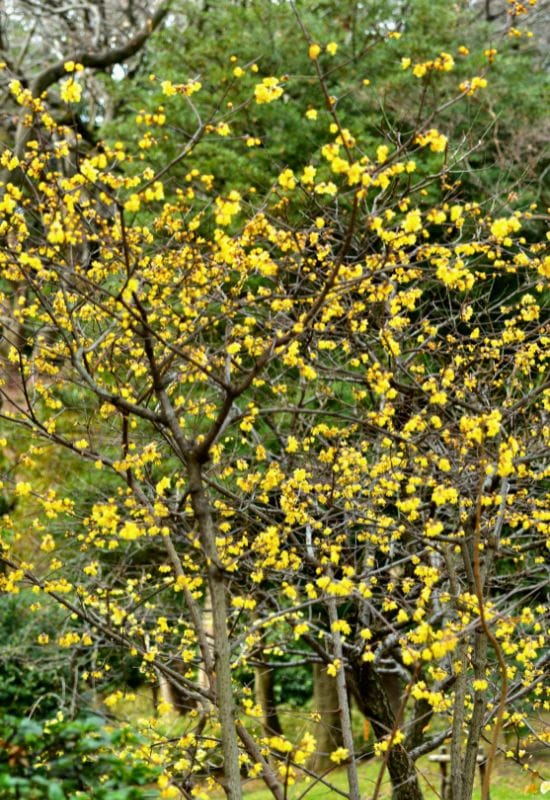
And we come to the last beauty on our list, aptly called wintersweet! This shrub comes from China, with its early blossoms that start un mid winter (or late in colder climates), and, depending on the weather, they can brighten up your garden till early spring. Appearing on the still naked branches, the flowers are not big, but they are quite attractive indeed! Look at them at close range, and they may remind you of water lilies – at least the do to me…
The outer tepals form a multi-pointed with an ivory to cream white color, and they have an extra quality too: they are waxy, and translucent… Then, there is an internal row of purple tepals, and a central reproductive column, again, in cream white… But there is more for your cold days, as its name suggests, the blooms are really fragrant, and yes, sweetly so!
However, you need to be patient, because this shrub will take a few years before it offers you its floral display. On the other hand, when this spectacle is over, it will grow its lance shaped and deep green leaves, which will keep you fresh during the hot days of summer, before turning yellow in fall to bid you farewell…
Easy to grow and well behaved, wintersweet is a really precious shrub to grow in your garden for winter interest – or actually, year-round. While it has an exotic touch, so you could grow it in an oriental landscape, it is quite delicate. So, you can easily fit it into a traditional setting, from a country or cottage garden, to urban and suburban gardens, as long as they are informal. As a specimen, or in a flowering hedge, it will reward you for many many years!
Keep Your Garden Filled with Flowers Through the Cold Winter Season with One (or More) of These Plants!
So, you won’t need to look out of the window and see an empty, colorless and forlorn winter garden any more! Even if you live in a cold country, or a continental or temperate region, there are varieties of perennials, shrubs and trees that blossom in this usually flowerless season… And you have quite a big choice too… Small or tall, exotic or traditional looking, there are blooms for your land to fit all tastes and needs!

Written By
Amber Noyes
Amber Noyes was born and raised in a suburban California town, San Mateo. She holds a master’s degree in horticulture from the University of California as well as a BS in Biology from the University of San Francisco. With experience working on an organic farm, water conservation research, farmers’ markets, and plant nursery, she understands what makes plants thrive and how we can better understand the connection between microclimate and plant health. When she’s not on the land, Amber loves informing people of new ideas/things related to gardening, especially organic gardening, houseplants, and growing plants in a small space.

